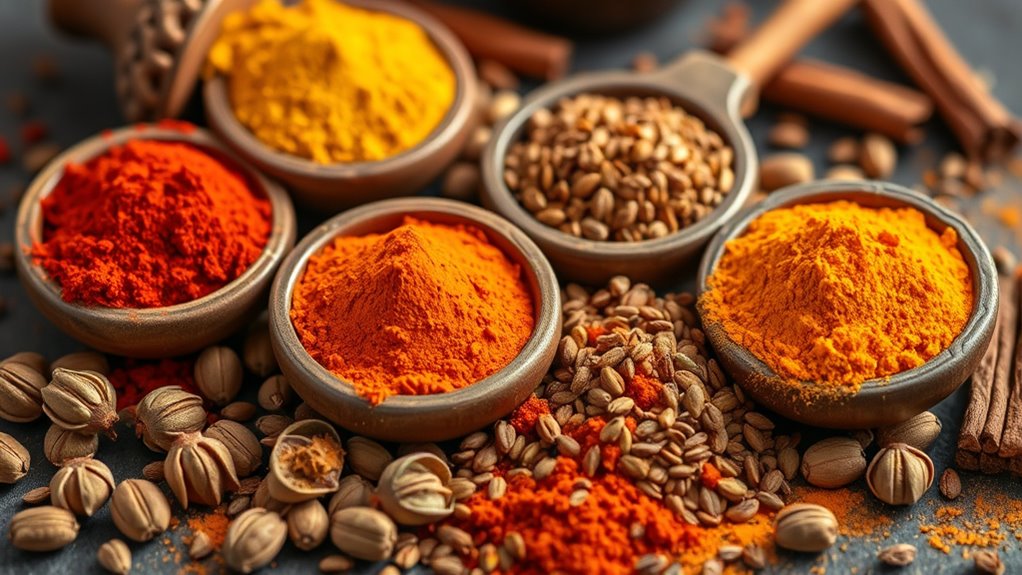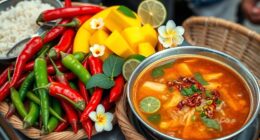Indian spices are the core of authentic Indian cuisine, bringing vibrant flavors and rich aromas to every dish. You’ll find blends like garam masala and turmeric that not only enhance taste but also offer health benefits like anti-inflammatory qualities and improved digestion. Toasting spices intensifies their flavor, and their versatility lets you create everything from savory curries to sweet desserts. Continue exploring, and you’ll uncover how these spices tell stories of history, culture, and endless culinary artistry.
Key Takeaways
- Indian spices are vital for creating the vibrant flavors and aromas that define Indian cuisine.
- Crafted spice blends like garam masala add depth and complexity to dishes.
- Spices such as turmeric and cumin offer health benefits alongside flavor enhancement.
- Toasting spices before grinding intensifies their aroma and taste, elevating dishes.
- Their versatility allows use in both savory and sweet recipes, reflecting rich cultural traditions.

Have you ever wondered what gives Indian cuisine its vibrant flavors and rich aroma? The answer lies in its incredible array of spices, which are the heart and soul of every dish. These spices don’t just add flavor; they tell stories of history, culture, and tradition. When you cook Indian food, you’re not just preparing a meal—you’re creating a sensory experience that awakens your taste buds and transports you to a different world.
Indian spices are meticulously chosen and combined, each bringing its unique character to the table. From the fiery heat of chili to the warm earthiness of cumin, every spice plays a *vital* role in shaping the cuisine’s distinctive identity.
You might notice that many Indian dishes feature a complex blend of spices known as masalas. These masalas are carefully crafted mixtures that balance heat, sweetness, bitterness, and aroma. For example, garam masala, a popular blend, combines cinnamon, cloves, cardamom, and pepper to impart a warm, fragrant touch to curries and stews.
These blends aren’t just thrown together; they’re created with precision to enhance the dish’s depth and complexity. When you add these spices during cooking, they release essential oils and flavors, infusing the food with vibrant tastes that linger on your palate.
The use of spices in Indian cooking is also deeply rooted in health benefits. Many spices, such as turmeric, have anti-inflammatory properties, while others like cumin aid digestion. This holistic approach to flavor and wellness explains why spices are so integral to Indian cuisine.
You’ll find that spices are often toasted before being ground, a process that intensifies their aroma and flavor. This simple step can transform a bland mixture into a fragrant, flavorful base that elevates your cooking.
Moreover, Indian spices aren’t limited to savory dishes—they’re also used in sweets and beverages, adding a unique twist. Saffron, for instance, lends a golden hue and luxurious aroma to desserts, while cardamom enhances both sweet and savory recipes.
Their versatility allows you to experiment and create a wide range of dishes, each with its signature aroma and taste profile.
In essence, Indian spices are more than just ingredients—they’re the *cornerstone* of Indian culinary artistry. They connect you to centuries of tradition and craftsmanship, allowing you to explore a world of flavors that’s both exciting and comforting.
Understanding the science behind spice properties helps deepen your appreciation for how these ingredients not only flavor but also support health. With each pinch and sprinkle, you’re not just cooking; you’re honoring a rich cultural heritage that celebrates the power of spices to captivate and delight.
Frequently Asked Questions
What Are the Health Benefits of Indian Spices?
Indian spices offer numerous health benefits that you can enjoy daily. Spices like turmeric contain curcumin, which fights inflammation, while cumin aids digestion. Ginger boosts your immune system, and cinnamon helps regulate blood sugar levels.
Adding these spices to your meals not only enhances flavor but also supports your overall health. Embrace Indian spices to boost your energy and protect against various illnesses naturally.
How Should Indian Spices Be Stored for Freshness?
To keep your Indian spices fresh, store them in airtight containers away from heat, light, and humidity.
You should place these containers in a cool, dark spot like a pantry or cupboard.
Avoid storing spices near the stove or oven, as heat accelerates loss of flavor and aroma.
Regularly check for signs of spoilage, and consider grinding whole spices just before use for maximum freshness and flavor.
Are There Any Spices That Should Be Avoided During Pregnancy?
Think of pregnancy as a delicate garden needing careful tending. Some spices, like sage and parsley in large amounts, can cause complications, so you should avoid them.
Others, like turmeric, are generally safe in moderation and even beneficial.
Always consult your healthcare provider before adding new spices to your diet, ensuring your culinary choices nourish both you and your baby.
Your careful selection keeps your garden healthy and thriving.
How Can I Tell if Indian Spices Are Authentic?
To tell if Indian spices are authentic, start by checking their aroma and color. Genuine spices have a strong, vibrant scent and rich hue.
Buy from reputable stores or trusted vendors who source directly from India.
Avoid overly cheap or uniformly colored spices, as these might be adulterated.
Read labels carefully, and if possible, taste a small amount to verify the flavor. The flavor should be complex and fresh.
What Are Some Common Spice Blends Used in Indian Cooking?
You’re curious about common spice blends in Indian cooking, right? Some popular blends include garam masala, which combines cinnamon, cloves, and cardamom for warmth and depth.
Panch phoron, a five-spice blend with cumin, fenugreek, mustard seeds, and more, adds flavor to lentils and vegetables.
Curry powder is also widely used, though it varies regionally. These blends bring authentic flavor and aroma to your dishes.
Conclusion
Indian spices are the soul of the cuisine, bringing vibrant flavors and rich aromas to every dish. When you embrace these spices, you uncover a world of culinary magic that turns ordinary meals into extraordinary experiences. Think of it as adding a splash of color to a black-and-white sketch—you bring everything to life. So, don’t be afraid to experiment and let the spices guide your kitchen adventures, transforming simple ingredients into a feast for the senses.









